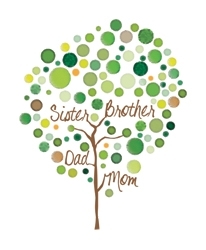For years, researchers have sought an avenue to deliver chemotherapy directly to retinoblastoma tumors – cancers of the retina of the eye, which primarily affect children under age 5. It turns out that the body itself offers just such a route.
ChildhoodCancer
A Doctor and a Dancer
As a cancer researcher, Kimberly Stegmaier, MD, says her chosen profession offers “the mystery and excitement of discovery.” And she says the same is true of her passion outside the laboratory: dance.
“It’s a huge hook for me,” she says. Both in scientific research and in working on a dance piece, Stegmaier explains, “You start out testing a hypothesis or an idea, and you don’t know what the results will be. The magic of that unfolding is wonderful.”
Swollen lymph nodes in children: When to seek care
Although swollen lymph nodes (also known as swollen glands) are usually a sign of an infection or inflammation, they can, very infrequently, be a sign of cancer or a rare disorder.
Rachael Grace, MD, and Christopher Weldon, MD, PhD, co-directors of Dana-Farber/Boston Children’s Cancer and Blood Disorders Center’s Node Assessment Program in Waltham, Mass., offer the following tips for families worried about “lumps and bumps” in their children.
Making a party out of cancer
Every Sunday, the Cutter family holds a Chemofeast. The door to their home is open to any and all who wish to attend. It’s a day full of food, beverages, and a lot of laughter, and 15-year-old Blake Cutter gets to choose the menu. Then on Monday, his mother, Lois, drives him to chemotherapy at Dana-Farber.
Cancer survivor, 17, has ‘go for it’ approach
Maddie Dillon, 17, did not really understand what cancer was when she was diagnosed at age 8. With the help of Dana-Farber’s Jimmy Fund Clinic, she beat her leukemia, but only briefly. Six months later it came back, and she went through more treatment.
Meet Henry: a cancer survivor who was diagnosed before he was born
Henry Fenollosa’s problems began before he was born, when he was diagnosed with neuroblastoma. His infancy was was spent largely at Dana-Farber’s Jimmy Fund Clinic, where he received treatment for his disease with his family looking on. Today, Henry’s an active seven-year-old, who loves to show off his lacrosse stickhandling abilities and his skill on … Read more
A cancer survivor at age 9
In celebration of Living Proof week, Insight honors cancer survivors with daily posts about survivorship.
To look at 9-year-old baseball player and Lego champion Charlie Rider, you’d never guess he’d had cancer for nearly half his life.
Why pediatric survivor programs are so important
In celebration of Living Proof week, Insight honors cancer survivors with daily posts about survivorship.
When Dana-Farber launched its David B. Perini, Jr. Quality of Life Clinic nearly 20 years ago, it was one of the nation’s first programs dedicated to helping childhood cancer survivors.
From the beginning, the pediatric survivorship clinic has been guided by clinic director Lisa Diller, MD, who is recognized globally for her contributions to cancer survivorship and pediatric oncology. The Perini clinic has developed resources that help survivors address issues such as the long-term effects of treatment, the risk of second cancers, and the psychological concerns of being a cancer survivor.
Therapy dogs bring smiles to kids with cancer
With the pitter patter of small feet, Phil makes his way through the halls of Boston Children’s Hospital. He walks with a purpose, boarding the elevator that takes him to the oncology floor for his next appointment.

Phil is a new face in 6 North, the oncology unit at Dana-Farber/Boston Children’s Cancer and Blood Disorders Center. A spunky pug mix who knows a trick or two, Phil is one of nine therapy dogs who visit pediatric patients at Boston Children’s Hospital as part of the Pawprints Program. What he lacks in medical credentials and size, he easily makes up for in heart.
A new approach to old ideas about diffuse intrinsic pontine glioma
Hilary Olson had no reason to suspect that her daughter Hailey might have a brain tumor.
“Her smile was starting to droop a little, and one of her eyes was a little jumpy,” says the 6-year-old’s mother. “We took her to see a neurologist, and he thought she might have pinched a nerve.
“But when he sent us to Boston Children’s Hospital for an MRI,” she continues, “the radiologists sent us straight down to the emergency room.”
Two dads, one cause, and a whole lot of love
 No one would choose the way Glen Jusczyk and Greg Kelly became friends: at the bedsides of their little girls with cancer. Yet these extraordinary circumstances created not just a friendship, but a desire to give back to the place providing their children’s care.
No one would choose the way Glen Jusczyk and Greg Kelly became friends: at the bedsides of their little girls with cancer. Yet these extraordinary circumstances created not just a friendship, but a desire to give back to the place providing their children’s care.
On April 16, these dads, who consider themselves “out of shape,” will run the 116th Boston Marathon® as two of more than 550 runners on the Dana-Farber Marathon Challenge team to raise money for the Claudia Adams Barr Program in Innovative Basic Cancer Research at Dana-Farber.
Jusczyk’s daughter, Malia, was diagnosed with neuroblastoma, a cancer that forms in nerve tissue and mostly affects young children, when she was just 2 years old. The family moved from Orlando, Florida, to Boston shortly after the news so she could be treated in the Neuroblastoma Program at Dana-Farber/Boston Children’s Cancer and Blood Disorders Center, which provides research and the latest treatments.
“We packed our bags as soon as we could,” recalls Jusczyk. “We have family in the Boston area and we wanted Malia to be at the best cancer center in the world for her disease.” There, Jusczyk met Kelly, whose 5-year-old daughter, Charlotte, was across the hall fighting the same type of cancer.
Family bonding in the Jimmy Fund Clinic
 By Sara Dickison Taylor
By Sara Dickison Taylor
When our daughter Emily was diagnosed with leukemia at age 5, we found solace and support from other families facing pediatric cancer at Dana-Farber/Boston Children’s Cancer and Blood Disorders Center.
Our visits to Dana-Farber’s Jimmy Fund Clinic became a well-rehearsed play. If it was Friday, it was clinic day. Instead of going to kindergarten or playing with her friends like most 5-year-olds, Emily had her vital signs taken, had blood drawn through her Port-a-Cath, and received a weekly infusion of chemotherapy, platelets, and blood. It was difficult at times, but making friends with other families going through the exact same thing made it bearable.
It takes a village to help you through a child’s cancer treatment, and that includes other families as well as our clinical care team. The Jimmy Fund Clinic usually schedules appointments so that children come in on the same day each week – giving their patients and families a real sense of continuity. We forged relationships with many other “Friday families.” Seeing familiar faces lifted us up and offered a sense of comfort that was just as important for us parents as for the kids. The clinic became a small community for us – our own village.
Mattel announces hairless version of Barbie doll
 Mattel Inc., maker of Barbie dolls, last week announced that it would create a bald version of the popular fashion doll to support people battling cancer.
Mattel Inc., maker of Barbie dolls, last week announced that it would create a bald version of the popular fashion doll to support people battling cancer.
The announcement came a few months after Beautiful and Bald Barbie, a Facebook group that petitioned Mattel to make a hairless version of the doll, gained mass support online. Their mission was simple:
We would like to see a Beautiful and Bald Barbie made to help young girls who suffer from hair loss due to cancer treatments, alopecia or trichotillomania. Also, for young girls who are having trouble coping with their mother’s hair loss from chemo. Many children have some difficulty accepting their mother, sister, aunt, grandparent or friend going from long-haired to bald.
“A hairless doll could really present a great opportunity for families and medical providers to talk about illness and hair loss with kids facing those issues,” says Cori Liptak, PhD, a psychologist in the Division of Pediatric Psychosocial Services at Dana-Farber/Boston Children’s Cancer and Blood Disorders Center. “It could also be an interactive way for some children to express their emotions about their own medical experience.”
Advocating for student cancer survivors
 At age 7, Sophie was treated for a brain tumor at Dana-Farber/Children’s Hospital Cancer Center. As a result of her treatment, she struggled with ongoing fatigue, weakness on her right side, and chronic headaches.
At age 7, Sophie was treated for a brain tumor at Dana-Farber/Children’s Hospital Cancer Center. As a result of her treatment, she struggled with ongoing fatigue, weakness on her right side, and chronic headaches.
Sophie began her freshman year as one of 2,000 students at a large public high school. Despite support from special education teachers, she struggled with the academic demands of her classes and the overwhelming size of the school. An extremely dedicated student, she spent hours each evening on homework, but she tired easily, which made the headaches worse, and she struggled to get through each school day.
More children than ever are surviving cancer. But some will pay a price in long-term effects. Radiation and chemotherapy for cancers involving the central nervous system (including brain tumors and leukemia) can impair problem-solving, multi-tasking, attention, and memory, putting students at risk for learning difficulties.
Cancer treatment and fertility: Planning for the future
Imagine being 22 and having your two biggest fears come true: You have cancer, and your treatment may leave you unable to have children in the future.
While you’re still coming to terms with the diagnosis, you now have to make some major life decisions. Do you want to freeze your eggs? Or should you choose a sperm donor and freeze fertilized eggs instead? Don’t forget to consider your husband’s feelings — even though he isn’t even in your life yet.
Treating childhood cancer worldwide
On International Childhood Cancer Day, it’s important to remember that global support, research, and treatment are vital to ensuring that children in developing countries have the same chance at survival as their peers in the U.S. Physicians such as Dr. Leslie Lehmann from Dana-Farber/Boston Children’s Cancer and Blood Disorders Center travel all over the world to deliver expert, curative care to young patients with cancer. Here is her story.
Rwanda is a tiny country in central Africa with much beauty but few resources. The genocide in 1994 that killed nearly a million people also devastated the health care system. Many people do not receive basic health care services and cancer care was nonexistent. It was impossible to even tell how common cancer was – people would die from a mass, or from bleeding, or infection without ever having a diagnosis.
The country has over 11 million people with not a single physician trained in caring for people with cancer. It’s a very sad situation.
This is beginning to change a bit. Through the Partners in Health (PIH) organization, I became part of a U.S.– Rwandan team led by Sara Stulac, PIH’s director of pediatrics, assembled at the Rwinkwavu hospital with the goal of providing consistent quality care to children with cancer. Sara had lived in Rwanda working at this rural PIH-sponsored hospital for six years. I went to Rwanda with Kathleen Houlahan, a pediatric oncology nurse and nurse director of the Jimmy Fund Clinic at Dana-Farber/Boston Children’s Cancer and Blood Disorders Center, and Dr. Larry Shulman, medical oncologist and chief medical officer of Dana-Farber, who is Senior Oncology Adviser for PIH and leads Dana-Farber/Brigham and Women’s Cancer Center efforts in Rwanda.
Bringing cancer care to Rwanda
By Lawrence Shulman, MD
Dana-Farber, with our partners Brigham and Women’s Hospital and Boston Children’s Hospital, offers patients highly advanced treatments in modern facilities. Our patients also benefit from an excellent staff, clinical research, and extensive resources, and many of them survive cancer to live long and healthy lives.
Is it fair, then, that cancer remains a death sentence elsewhere in the world? In Rwanda, for example, a country of 10 million people, cancer care has been completely unavailable to almost all patients. They die of cancers that could have been cured in Boston.
Genetic counseling now recommended for children with sarcoma
 If your son or daughter has been diagnosed with a type of sarcoma – a tumor in connective tissue like muscles or bones – there are many questions: Will my child make a full recovery? What are the immediate and long-term side effects of treatment?
If your son or daughter has been diagnosed with a type of sarcoma – a tumor in connective tissue like muscles or bones – there are many questions: Will my child make a full recovery? What are the immediate and long-term side effects of treatment?
Most parents don’t consider whether their child will face a second cancer later in life.
However, a link between sarcomas and Li-Fraumeni syndrome, a rare condition that raises a person’s risk of developing one or more cancers to as high as 85 percent, has led genetic specialists at Dana-Farber/Boston Children’s Cancer and Blood Disorders Center to recommend that all child sarcoma patients be offered genetic counseling for Li-Fraumeni syndrome.
